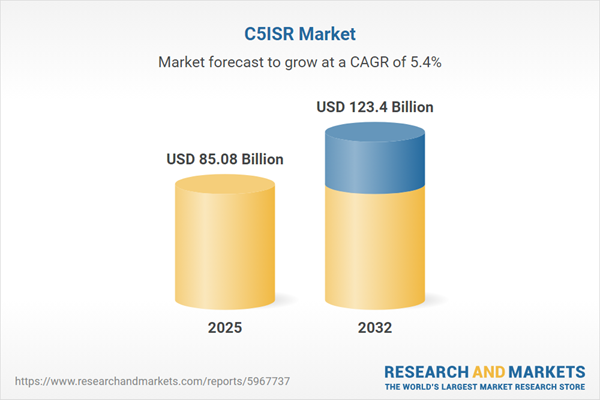Speak directly to the analyst to clarify any post sales queries you may have.
The C5ISR market is rapidly evolving as defense organizations worldwide prioritize integrated command, control, communications, computers, cyber, intelligence, surveillance, and reconnaissance solutions. Heightened security needs, combined with digital and technological transformation, are shaping new investment priorities and operational strategies for the sector.
Market Snapshot: C5ISR Market Size and Growth Outlook
The C5ISR Market grew from USD 80.90 billion in 2024 to USD 85.08 billion in 2025 and is projected to advance at a CAGR of 5.42%, reaching USD 123.40 billion by 2032. This growth reflects robust demand for advanced integrated defense systems and intelligence capabilities, driven by intensifying geopolitical uncertainties and rapid technological disruption.
Scope & Segmentation
- Component: Hardware, Services, Software
- Hardware: Communications Equipment, Computing Devices, Sensors, Transport Platforms
- Services: Integration Services, Maintenance Services, Training & Consultation
- Software: Communication Software, Cybersecurity Software, Simulation Software
- Product Offerings: Command & Control Systems, Cybersecurity Solutions, Integrated Communication Systems, Simulation & Training Systems, Surveillance & Reconnaissance
- Platform: Airborne Systems, Land Systems, Naval Systems, Space Systems
- Application: Cyber Crisis Management, Disaster Response, Electronic Warfare & Tactical Management
- End User Categories: Armed Forces (Air Force, Army, Marine Corps, Navy), Commercial Entities, Government Agencies (Emergency Services, Intelligence Agencies, Law Enforcement)
- Regional Coverage: Americas (North America: United States, Canada, Mexico; Latin America: Brazil, Argentina, Chile, Colombia, Peru), Europe, Middle East & Africa (United Kingdom, Germany, France, Russia, Italy, Spain, Netherlands, Sweden, Poland, Switzerland, UAE, Saudi Arabia, Qatar, Turkey, Israel, South Africa, Nigeria, Egypt, Kenya), Asia-Pacific (China, India, Japan, Australia, South Korea, Indonesia, Thailand, Malaysia, Singapore, Taiwan)
- Companies Analyzed: Airbus Group SE, BAE Systems PLC, Boeing Company, Booz Allen Hamilton Holding Corporation, CACI International Inc, Cobham Limited, Curtiss-Wright Corporation, Elbit Systems Ltd., FLIR Systems, Inc., General Dynamics Corporation, Honeywell International Inc., Huntington Ingalls Industries, Inc., Indra Sistemas SA, Kratos Defense & Security Solutions, Inc., L3Harris Technologies, Inc., Leidos Holdings, Inc., Leonardo S.p.A, Lockheed Martin Corporation, Northrop Grumman Corporation, Raytheon Technologies Corporation, Rheinmetall AG, Saab AB, SAIC, TE Connectivity plc, Thales Group
Key Takeaways
- The C5ISR market is being reshaped by the convergence of artificial intelligence, machine learning, adaptive cybersecurity platforms, and edge computing, empowering forces with actionable intelligence and operational superiority.
- Integrated open architecture frameworks are gaining momentum, allowing for flexible, modular system design that enhances interoperability and streamlines upgrades.
- Regional adoption trends vary: Americas are prioritizing modernization and interoperability; EMEA is upgrading legacy systems and focusing on cross-border collaboration; Asia-Pacific is accelerating advanced technology integration and localized production.
- Hardware remains the core driver of investment, but rising demand for resilient, continuous lifecycle services, and software solutions is accelerating subscription-based procurement models.
- Defense contractors are increasingly forming partnerships with commercial technology firms and regional integrators to diversify capabilities and meet unique localization and offset requirements.
- Emerging multi-domain operations and contested security environments are pushing requirements for real-time data fusion, secure communication, and modular upgradability across platforms.
Impact of the 2025 United States Tariff Regime
The imposition of expanded tariffs in 2025 has prompted defense supply chain re-evaluation. Prime contractors are progressing toward local sourcing and deeper partnerships with domestic manufacturers to manage risks arising from import duties, shipping disruptions, and compliance challenges. These shifts are resulting in longer lead times and increased upfront costs, but they are also driving investment in national manufacturing capacity and fostering new collaborative procurement strategies among allied nations and industry partners.
Methodology & Data Sources
This report uses a multimodal research approach, combining primary interviews with senior defense officials, technology innovators, and integrators. It is supported by secondary data from open-source intelligence, official procurement databases, company disclosures, and defense-focused white papers. Rigorous data validation, cross-checks, and expert review underpin trustworthy market insights and recommendations.
Why This Report Matters
- Enables senior decision-makers to benchmark evolving C5ISR opportunities and procurement risks under shifting geopolitical and regulatory conditions.
- Provides actionable insights into technology adoption, supply chain resilience, and partner alignment across diverse operational environments.
Conclusion
The C5ISR sector stands at a critical inflection point, shaped by fast-changing technologies and supply chain realities. Decision-makers empowered with this intelligence can realign strategy, strengthen partnerships, and sustain mission readiness in multi-domain operations.
Additional Product Information:
- Purchase of this report includes 1 year online access with quarterly updates.
- This report can be updated on request. Please contact our Customer Experience team using the Ask a Question widget on our website.
Table of Contents
3. Executive Summary
4. Market Overview
7. Cumulative Impact of Artificial Intelligence 2025
Companies Mentioned
The companies profiled in this C5ISR market report include:- Airbus Group SE
- BAE Systems PLC
- Boeing Company
- Booz Allen Hamilton Holding Corporation
- CACI International Inc
- Cobham Limited
- Curtiss-Wright Corporation
- Elbit Systems Ltd.
- FLIR Systems, Inc.
- General Dynamics Corporation
- Honeywell International Inc.
- Huntington Ingalls Industries, Inc.
- Indra Sistemas SA
- Kratos Defense & Security Solutions, Inc.
- L3Harris Technologies, Inc.
- Leidos Holdings, Inc.
- Leonardo S.p.A
- Lockheed Martin Corporation
- Northrop Grumman Corporation
- Raytheon Technologies Corporation
- Rheinmetall AG
- Saab AB
- SAIC
- TE Connectivity plc
- Thales Group
Table Information
| Report Attribute | Details |
|---|---|
| No. of Pages | 199 |
| Published | November 2025 |
| Forecast Period | 2025 - 2032 |
| Estimated Market Value ( USD | $ 85.08 Billion |
| Forecasted Market Value ( USD | $ 123.4 Billion |
| Compound Annual Growth Rate | 5.4% |
| Regions Covered | Global |
| No. of Companies Mentioned | 26 |









